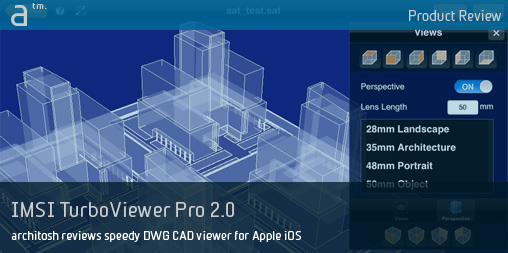Last year in the early summer Royal Farros, Chairman and CEO of IMSI/Design, made a pretty powerful statement. He said, “We really believe that the iPad represents an inflection point in the industry. It has phenomenal portability with its very long battery life…and with Multi-touch you simply can’t match what it can do with any other computing device.”
After reviewing TurboViewer 2.0, our previous view that Farros was already speaking our language, was further confirmed. It is not just that he is making a bold prediction about the impact of a game-changing device–anyone can do that! But rather that IMSI/Design is clearly showing what they mean by “inflection point” in the CAD industry.
The Key is Immediacy
On a personal note, I’ve been toting around an Apple iPad 2 since it came out. I couldn’t wait to use it as a tool for practicing architecture. I was very excited about what I could possibly do out in the field and what older processes could be replaced by this new tool. I was particularly interested in “speeding up” work flow processes that normally were tied down to limitations in the field or repetition back at the office or both. But here is what I learned: if the new process on the iPad isn’t fast enough to keep up with the old analog process, it doesn’t matter all that much if you are speeding up workflows downstream.
Let me explain it more clearly. Say you typically take field meeting notes on a pad of paper. Then you type up those notes back at the office. Say you often sketch up details and ideas for the client or the contractor as part of those notes on paper. Now you have an iPad. And you want to do all this work directly in the field and not burden yourself with the conversion from analog to digital back at the office. In theory, you should save time. But here is the rub. If the process on the iPad is anywhere more than 25 percent slower than the old analog process, you will not find the reward you are looking for. And if the process needs to keep pace with the flow of meetings, then it must be just as fast as analog or faster.
As it turns out, not a lot of iOS apps for AEC professionals meet this criteria yet. They offer streamlining by “everywhere access” and elimination of “double data entry” back at the office, but if you can’t keep up with others or an existing workflow it doesn’t matter how great the tool is–eventually you will stop using it.
Why TurboViewer Pro Succeeds
Given that criteria then, the reason why TurboViewer and TurboViewer Pro succeed as top notch tools in the new mobile app space is this: They are simple viewers that provide the market with CAD file viewing needs that normally have been served with mobile laptops. But they exceed laptops because they view the data faster, provide easier mobility, and also provide unique “one-of-a-kind” viewing experiences.

01 – Pixar’s Wall-E robot is the star of this CAD file. The Views menu is shown in TurboViewer Pro 2.0. Selecting a view choice switches to that saved view.
Let’s start with the uniqueness factor. With TurboViewer and its Pro sister app you have the power to spin 3D models around effortlessly with your finger tip. It is like having the object in your hand. The combination of Apple’s Multi-touch user-interface and CAD/3D is wonderful when it is delivered this smoothly. And it is very smooth! Take the Wall-E.dwg file shown in the image above. (see image 01). TurboViewer Pro gives you an excellent Views menu with easy to understand icons and viewing options. It is so easy to reach out and touch the object on the screen and start spinning little Wall-E around.
If you get to where you have lost control and spun the model around in a way you don’t like (sometimes that can happen) you simply re-choose a typical view from the Views menu. (image 01) From there you have the option of axon, and all the various sides of an object. And with the Pro version you get Perspective options as well, giving you preconfigured lens starting at 28mm Landscape mode up to 50mm Object mode. (see image 03)

02 – Visual styles are available and the Pro version features X-ray mode, which is very useful for architecture urban design model files. You also have Perspective as an option.

03 – In the Pro version you have “Perspective” in addition to side and axon views. Camera options are available, including Custom.
Other unique things that are not so easy to do in a CAD application on a laptop are the simple way you can switch to various visual styles. You can easily toggle between line view, hidden line view, X-ray mode, shaded openGL and more. The X-ray mode is particularly cool for buildings; SketchUp users in particular with be at home with this viewing method. (see images 02)
next page: Other Details & Closing Comments





Reader Comments
Comments for this story are closed